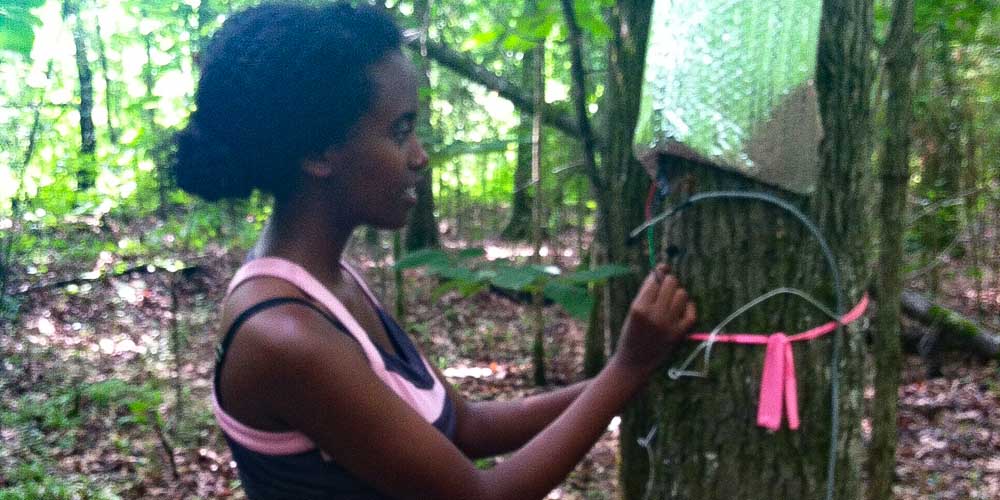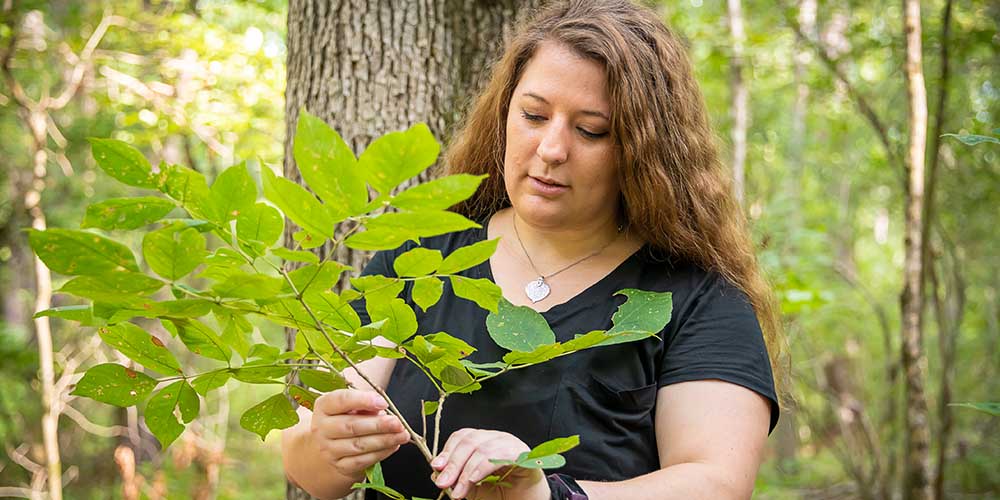Forest Biology and Watershed Management Stories

What Lies Beneath the Surface
Learning how trees use water is essential to preserving forest ecosystems in climates that are growing wetter than their historic averages, in some cases, or drier, in others. Dr. Heidi Renninger, FWRC associate forestry professor, conducted a study to determine how different species of trees adapt and survive in changing climates. The team placed sensors around select trees in the John W. Starr Memorial Forest, close to the MSU campus in Starkville, recording the movement of water through the trees. Initial results found that certain species, such as willow oak, swamp chestnut oak, and green ash are more drought tolerant, and others, such as winged elm, American elm, cherrybark oak, and shagbark hickory, are more sensitive to drier conditions.
Once complete, the results of the study will help land managers understand which trees will be the most successful under future climate conditions.
2017

Anticipating Invasive Insect Impact Before the Threat Arrives
Invasive insects, like the emerald ash borer and the redbay ambrosia beetle, wreak havoc on native ecosystems, kill hundreds of millions of trees, and cost hundreds of millions of dollars per year in lost revenue, management costs, and loss of ecosystem services in North America. Dr. Ashley Schulz, assistant forestry professor, is part of a team working to predict whether insect species will highly-impact North American conifers and hardwoods before they arrive here. team has a dataset of 300 European insects that have not yet arrived in North America and is establishing a baseline to determine which insects will be risky. The work was published in Biological Invasions and the team is now incorporating their models into a new pest predictor tool for i-Tree, a peer-reviewed software suite from the USDA Forest Service and Davey Tree Expert Company that produces forestry analysis and benefits investment tools. The research is funded through the United States Geological Survey John Wesley Powell Center, the USDA Forest Service National Urban and Community Forestry Advisory Council, and the MSU Forest and Wildlife Research Center.
Collaborators include the University of Maine, Dartmouth College, the University of Georgia, Colorado State University, Arkansas State University, University of Wisconsin, University of Washington, University of Nebraska, the USDA Forest Service, the United States Geological Survey Southwest Biological Science Center, and Davey Tree Expert Company.
2022

How Diversification of Tree Species Helps Timber and Wildlife
Bottomland forests reduce the risk and severity of downstream flooding by providing areas to store floodwater. These wetlands also improve water quality by filtering and flushing nutrients, processing nitrates and organic wastes, and reducing sediment before it reaches open water. Dr. Joshua Granger, an assistant forestry professor, and his team aim to demonstrate novel silvicultural techniques to restore floodplain forests and wildlife habitat across Mississippi and Arkansas. The team plans to restore 344 acres of degraded natural bottomland hardwoods and 400 acres of early-rotation bottomland hardwood plantations across the four sites. Dr. Dana Morin, assistant professor in the Department of Wildlife, Fisheries and Aquaculture, leads the wildlife monitoring aspect of this project.
Morin and her team are sampling the study areas, collecting fecal pellets from swamp rabbits to extract DNA, identifying individuals, and estimating abundance before and after restoration activities to assess how swamp rabbit populations respond. The team is also underplanting, or planting under the trees with lower-growing plants. As the research continues, the researchers are excited to diversify the land while restoring habitats and the environment. This research is sponsored by the National Fish and Wildlife Foundation. In addition to Granger, the MSU forestry team includes Drs.
Krishna Poudel, Brady Self, and Robert Grala, and Timothy Gatlin, forestry graduate student. Collaborators in the Department of Wildlife, Fisheries and Aquaculture, in addition to Morin, include Drs. Mark McConnell and Brian Davis; and Chloe Beall, WFA graduate student.